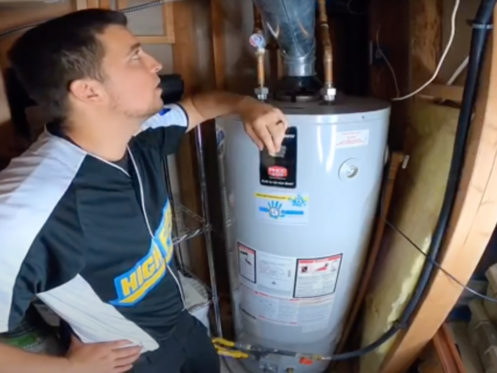Tips on How to Keep Your Home's Hot Water System in Good Condition
Tips on How to Keep Your Home's Hot Water System in Good Condition
Blog Article
Were you interested in resources on What Kind of Maintenance Do Water Heaters Need??

Warm water is important for day-to-day comfort, whether it's for a rejuvenating shower or washing meals. To guarantee your hot water system runs successfully and lasts longer, routine upkeep is essential. This article provides sensible ideas and understandings on just how to maintain your home's warm water system to avoid interruptions and pricey fixings.
Intro
Preserving your home's warm water system could seem overwhelming, but with a few straightforward steps, you can ensure it runs efficiently for years to find. This overview covers every little thing from recognizing your hot water system to DIY upkeep tips and knowing when to call expert aid.
Significance of Keeping Your Warm Water System
Routine upkeep not only extends the life expectancy of your warm water system yet likewise guarantees it runs successfully. Neglecting maintenance can result in reduced effectiveness, higher energy bills, and even premature failure of the system.
Signs Your Hot Water System Needs Upkeep
Knowing when your warm water system requires focus can prevent major issues. Look out for indications such as inconsistent water temperature, unusual noises from the heater, or rusty water.
Flushing the Water Heater
Purging your hot water heater gets rid of debris build-up, boosting performance and lengthening its life.
Monitoring and Changing Anode Rods
Anode poles stop rust inside the container. Evaluating and changing them when broken is critical.
Facility Issues Calling For Specialist Assistance
Instances consist of major leakages, electric troubles, or if your water heater is regularly underperforming.
Routine Specialist Upkeep Perks
Professional upkeep can consist of complete examinations, tune-ups, and making sure compliance with safety standards.
Examining and Changing Temperature Setups
Changing the temperature setups guarantees optimal performance and safety.
Do It Yourself Tips for Upkeep
You can do numerous maintenance jobs yourself to keep your hot water system in leading condition.
Looking for Leakages
Frequently examine pipes and connections for leaks, as these can lead to water damage and higher bills.
Comprehending Your Warm Water System
Prior to diving into maintenance tasks, it's valuable to recognize the fundamental parts of your warm water system. Typically, this includes the water heater itself, pipes, anode poles, and temperature controls.
Regular Monthly Upkeep Tasks
Routine monthly checks can aid capture minor problems prior to they escalate.
Checking Pressure Relief Valves
Checking the stress relief valve ensures it works properly and protects against extreme stress buildup.
Protecting Pipelines
Insulating warm water pipelines minimizes heat loss and can save power.
When to Call an Expert
While do it yourself maintenance is beneficial, some problems call for professional experience.
Final thought
Normal maintenance of your home's hot water system is essential for effectiveness, durability, and expense financial savings. By following these ideas and recognizing when to look for professional assistance, you can make sure a reputable supply of warm water without unanticipated disruptions.
How to Maintain an Instant Hot Water Heater
Before tinkering with your hot water heater, make sure that it’s not powered on. You also have to turn off the main circuit breaker and shut off the main gas line to prevent accidents. Also turn off the water valves connected to your unit to prevent water from flowing into and out of the appliance. 2. When you’re done, you have to detach the purge valves’ caps. These look like the letter “T†and are situated on either side of the water valves. Doing so will release any pressure that has accumulated inside the valves while at the same time avoid hot water from shooting out and burning your skin. 3. When the purge valves’ caps are removed, you have to connect your hosing lines to the valves. Your unit should have come with three hoses but if it didn’t, you can purchase these things from any hardware or home repair shops. You can also get them from retail stores that sell water heating systems. Read the user’s manual and follow it to complete this task properly. When the hosing lines are connected, open the purge port’s valves. 4. You should never use harsh chemical cleaners or solutions when cleaning your unit. Make use of white vinegar instead. It should be undiluted and you’ll probably use about 2 gallons. 5. Now flush your water heater. This task should probably take about 40 minutes. We can’t give you specific directions for this because the procedure is carried out depending on the type, model and brand of your heater. With that being said, refer to the user’s manual. 6. When you’re done draining the unit, you have to turn off the purge port valves again. Remove the hosing lines that you earlier installed on each of the water valves. Put the valve caps (purge port) back in their respective places and be very careful so as not to damage the rubber discs that are found inside these caps. 7. Now that everything’s back in place, check your user’s manual again to find out how to reactivate your water heating system. 8. Once it is working, turn one of your hot water faucets on just to let air pass through the heater’s water supply pipes. Leave the tap on until water flows smoothly out of it. https://www.orrplumbing.com/blog/2014/september/how-to-maintain-an-instant-hot-water-heater/

I found that blog entry about Tips For Maintaining Your Hot Water Heater while perusing the web. Sharing is nice. Who knows, you may be helping someone out. Thank you for your time. Please check our website back soon.
Recurring Service Plans Report this page